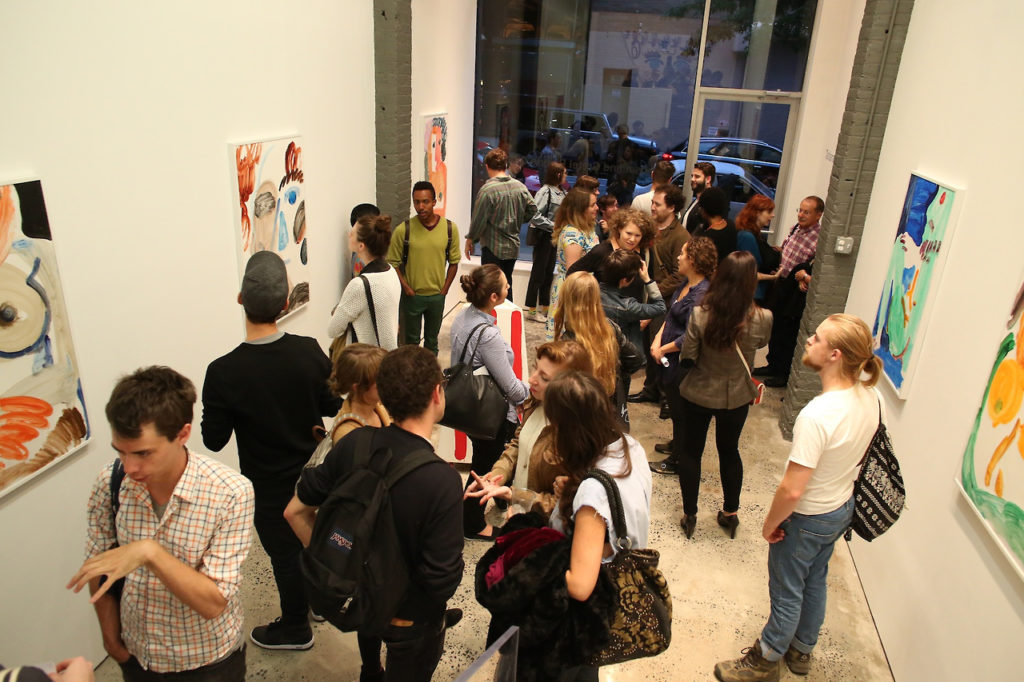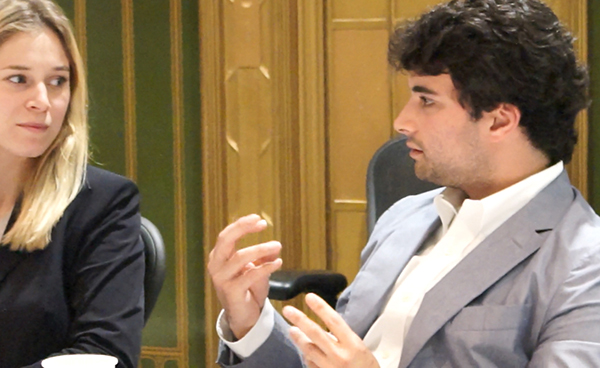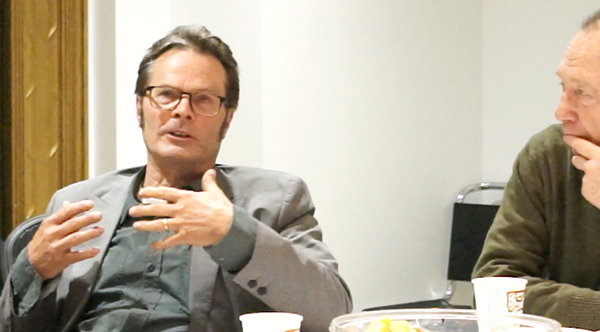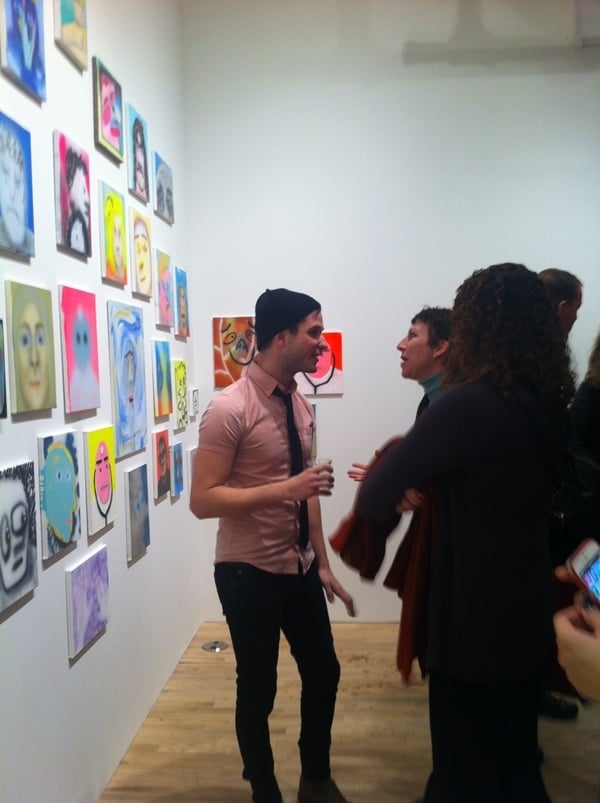

The transcript below features the conversation of an artnet roundtable discussion held in May 2014 in artnet’s offices in the Woolworth Building. The moderator was Anthony Haden-Guest, artnet News columnist and cartoonist, and author of the book True Colors: The Real Life of the Art World (Atlantic Monthly Press, 1988).
The participants were:
Joe Amrhein: Founder-director of Pierogi Gallery, located on North 9th Street in Brooklyn. The gallery’s artist roster includes Nadja Bournonville, Tony Fitzpatrick, Kim Jones, Daniel Zeller, and the late Mark Lombardi.
Tamas Banovich: Cofounder of Postmasters Gallery, located on Franklin Street. The gallery’s artist roster includes Holly Zausner, David Diao, Steve Mumford, William Powhida, and Wolfgang Staehle.
Sarah Christian: Cofounder of Hansel and Gretel Picture Garden, now merged with Pocket Utopia, located on West 22nd Street. The gallery’s artist roster includes Tatiana Berg, Drew Beattie, Rachel Libeskind, and Matthew Miller.
Benjamin Genocchio: Editor-in-Chief of artnet News
Magda Sawon: Cofounder of Postmasters Gallery.
Stefan Stux: Founder-director of Stux Gallery on West 57th Street. The gallery’s artist roster includes Dana Melamed, Dennis Oppenheim, Gia Edzgveradz, and Margaret Evangeline.
Jason Vartikar: Cofounder of Hansel and Gretel Picture Garden.
Douglas Walla: Founder of Kent Gallery on 11th Avenue. The gallery’s artist roster includes Dennis Adams, Mike Cockrill, Llyn Foulkes, Paul Laffoley, and Dorothea Tanning.
Anthony Haden-Guest: (To the group) This came out of a piece I wrote for artnet News about the closing of the Dodge Gallery. I spoke with Kristen Dodge and Ed Winkleman. And that same week there was a report that planetary warming was speeding up, and I thought Well, everything is speeding up. The art economy is speeding up. And this is really about that. The rise of mega galleries, franchises. And about the rise of art fairs. There’s a precise date for that, 1994. Before that, art fairs were trade fairs. I remember when John Baldessari was the only artist I had ever seen at an art fair. But in 1994, at the bottom of an art slump, four New York dealers gave a fair in the Gershwin hotel. Well, that’s where it started. But I am just the moderator. Feel free to raise any subject. It’s not like there’s a menu. Interrupt each other. This is just a conversation between people.
Stefan Stux: I remember how artists in the ’80s made the emphatic point that under no circumstances would they be represented in art fairs. (Laughter around the table) They thought that it was in poor taste. That is how it was in the beginning. And has been quite astonishing to see how things have turned around—in 30 years. There has been a total reversal.
Anthony Haden-Guest: But it is a considerable burden on smaller galleries, isn’t it?
Stefan Stux: Yes. And on major galleries also. But they are stuck, more and more. For better or worse.
Douglas Walla: The thing I find interesting in an economic sense is that what it does is that it propels the Artist Factory. Because you cannot really work fairs with an artist who makes two pictures a year. So what you see is the brand being pushed by somebody who can produce. So a tremendous amount of crap is being put on the market. To me as a dealer the most interesting thing is how the marketplace, the collectors, can’t distinguish between a work of art and a manufactured object. In the spirit of something. To me it’s a kind of Instagram crisis in a sense. For me the obstacle is the fact is that people are not physically experiencing work any longer. Traffic is way down in galleries. And you can say it’s partly because people have gone outside of [the system] in terms of trying to determine what kind of art is relevant.
Joe Amrhein: Is it really true that you think traffic is down?
Douglas Walla: I think absolutely.
Joe Amrhein: Have you experienced that on a day-to-day basis? In terms of the gallery flow?
Douglas Walla: Yes. Absolutely.

Sarah Christian and Jason Vartikar
Stefan Stux: I would second that point of view. Yes, it’s true.
Douglas Walla: I love making shows, I love making projects. It’s very gratifying and it’s very gratifying to the artist to perfect a kind of ambient space. But if nobody sees it? If people only see it on Instagram or on Facebook, it’s almost like you are creating information on a platform in the form of a website. It’s become a judgment. People feel they have experienced the content of a show without ever actually coming. So that they can write their report.
Tamas Banovich: I can imagine that in two or three years they actually will get rid of this requirement that you have to have a physical gallery to go to the art fairs. There are a lot of fake galleries now that exist somewhere just to be able to feed the art fairs.
Douglas Walla: I don’t think artists will go for that.
Magda Sawon: But I would like to make a more positive point. We have been 15 years in Chelsea. And then we left to build this space in Tribeca. Which is substantial. But we were incredibly fearful that nobody would go there. And it was propelled by our desire, just like yours (to Douglas Walla) to participate in the true level of dealing with art and artists and exhibiting work. And lo and behold, we have a following! So it’s not completely forgotten, the idea that people do in fact go to galleries. It’s propelled by coverage. People read things. But you still, I do think, have two audiences even with people who read. One is of people who read the blogs. And the other is of people who read whatever is left of so-called mainstream media. But I just cannot completely say that nobody goes to galleries any more.
Sarah Christian: I agree with that. Jason and I see two art worlds. One is these galleries that have been going a very long time. We see this world of diehard dealers who really promote their artists, invest in an artist’s career, show the work very intensely and profoundly. The other is the speculative art world, the Stefan Simchowitz pump and dump thing. And they are really divergent. Its two separate art worlds. Are we going to be in a civil war for the next 10 years?

Joe Amrhein and Anthony Haden-Guest
Benjamin Genocchio: So gallery traffic is down. Is the conversion rate for sales in galleries down as well? Or not? And how do you measure traffic? Most galleries have a website now. X number of people visit those websites. People are missing the physical experience but people are still engaged with what you’re doing. My question to you: Is the conversion rate of sales from physical visits to gallery down? Plus cost increases. And has there been a precipitous increase in the number of people accessing websites, even if it’s all just to look?
Jason Vartikar: From a website point of view, traffic is really, really hot. The reason is that it’s a huge military campaign. We’re twittering every 10 seconds. It’s an audience-building situation, a community-building situation. But that’s only because we’re on it all the time.
Benjamin Genocchio: And generation-wise, they’re happy to do that.
Jason Vartikar: Exactly.
Magda Sawon: Our sales are generated by him (indicates Tamas Banovich). The reason we felt kind of less petrified but at the same time encouraged to get out of clusters was that we looked at five years of our business. And not one transaction was connected to location. Those limos passed right by, nobody stopped. There are two art worlds. We operate in ours. So we’ll see.
Stefan Stux: But you had crowds.
Magda Sawon: We had tours.
Stefan Stux: I am talking about individuals coming by in crowds, so to speak.
Magda Sawon: Well, that’s an oxymoron. Individual people don’t come in crowds. The truth is we had tours, we had classes. And that is the first thing I thought that we were going to lose. But absolutely not. And that was a level of community-building. School children come. And they do their assignments. And then you have individuals who have checked the website. We also have a very strong social media presence. The reason for galleries to survive, like our gallery, is, I would say, diversity of what you present. We have been forever incredibly pluralistic, very hard to pigeonhole. We can show this or that kind of work. There is a freshness to the bulk of what is being shown, so they come.
Anthony Haden-Guest: (To Joe Amrhein) Joe, you have a very well-known gallery. But I very seldom see you at an art fair. Do you do them?
Joe Amrhein: A few, yeah. We did the Armory this year. I try to use the booth concept of a fair to show all the artists in a more cohesive way, a more curated way. But it’s frustrating in a way. It’s all boot-strapping and working to make it happen. You try to utilize the format of an art fair. Which is a love/hate relationship. It does draw the crowds but you’re part of that whole system. The artists and the gallery work well with the fair but it’s the tail wagging the dog, I think. It’s frustrating to be part of a system where the credibility of the gallery is really utilized by that fair. But we go into fairs as often as we would like. We might do more soon.
Anthony Haden-Guest: I am interested in the way that the social envelope of the art world affects the art that is being made. At Frieze in London a few years ago, I began seeing a lot of work that was clearly made for art fairs, work that was too big for the house of even an ordinarily rich person. I said I was baffled to a friend, a private dealer. He said You have no idea how many private museums are being built.
Jason Vartikar: There’s a feeling that bigger is stronger. And that is so not true.
Benjamin Genocchio: I think it makes sense that artists make work for art fairs. The whole fair event is spectacle. So to make work that works as spectacle in a spectacle context is easy. It just takes somebody with a little bit of ambition and understanding of what the context is. And it’s almost a guaranteed sale.
Stefan Stux: It also relates to an economic polarization, a rapid and really aggressive one that’s taking place in this country to the detriment of the art-buying middle class. The oligarchs, the superrich, that’s what I’m talking about, okay? Artists can produce these spectacles because the oligarchs buy that spectacle. Because it’s to their prestige, their image.
Benjamin Genocchio: You might think of that in relation to the art world, the concentration of capital in the hands of a few. What I’m talking about here is opportunity equality as opposed to income equality. There’s nothing you can do about income equality, but opportunity equality is more worrying to me. The opportunities begin to narrow and narrow and narrow as everything gets into the hands of a few successful dealers, a few successful artists. Artists are part of this too. If you look into the Christie’s catalogue there are statements in there. There’s one by Damien Hirst, there’s another one by Jeff Koons. They are totally different. But they actually talk about tapping into universal emotions. Everyone loves butterflies, everyone is afraid of sharks! So if you’re looking for a single justification of how you can make a successful art career, it’s there. Just tap into some universal fear or desire and promote it, promote it, promote it!
Joe Amrhein: The artist is trying to satisfy all these demands. How do they do this? Suddenly they have these teams of studio assistants. It changes the focus of the work.

Douglas Walla
Stefan Stux: We are actually the products of a different system where there was a strong middle class buying art. It’s the middle range I am talking about. Now they are selling their collections because they are being pinched economically. So actually the middle range, which is the one that is most vital, is the one that is suffering right now. And there is the real estate explosion. As far as prices are concerned in Chelsea, they are out of control. It is pushing out several galleries, including mine. It was a week ago that I moved uptown. I hope it was the right move, okay?
Benjamin Genocchio: Would you move to another city? Have you thought about that? Would you move to Brooklyn?
Stefan Stux: I thought about moving to Brooklyn years ago. But I made my way to Manhattan somehow. And I hope to die here, okay?
Laughter around the table.
Benjamin Genocchio: May I ask a question? Did any of you think of borrowing big sums of money to operationally fund an acquisition, with the idea that the value of that real estate would increase so substantially that you could pay it off?
Stefan Stux: I had a space on West 4th Street, just when it was developing. Yes. I thought about it. That was an opportunity to take advantage of. But right now I don’t know where you can get that kind of opportunity.
Magda Sawon: High value! That was Chelsea 20 years ago, that was the time to buy. Buy at the bottom, not the top of the market. Now you can buy in Sunnyside, Queens. Maybe! But for us none of the places we selected were available for sale. And we always selected for the quality of the space. (Shrugs.) I don’t know. That’s how it goes!
Joe Amrhein: Jersey is going to take off too.
Benjamin Genocchio: It seems to me, Magda, that it has to be considered a real estate situation. That is not something that in the past has ever been a preoccupation of dealers. But now they have to be aware of the real estate context. Otherwise it’s inevitable, from the sound of it, that you’ll be pushed out at some point. It’s just a matter of time.
Stefan Stux: Pat Hearn was one of the nicest people around. She was one of the first ones in Chelsea. I asked her how it was. She said “I love it. My program is very cheap. I don’t have to worry about money matters.” But that has been completely turned upside down, by what I call the Trojan horse of the Chelsea art world, which is the High Line. The city wanted to tear it down and sell it as scrap to China. It’s dead! But then the artists discovered it. A suspended park! They made it into an oasis. Right?
Magda Sawon: Right! But it’s not the artists’ fault!
Stefan Stux: No, no! It’s the dynamic of it. It’s nobody’s fault.
Tamas: It has always been that way. Everywhere in the world has got the same recipe.
Stefan Stux: Yes. But there’s an acceleration. The real estate scene, it’s like flies to the candy. If you walk around Chelsea now, it’s high-rises all over. And they’re all clustered around the High Line. And now there’s a trend to people being pushed out of 14th Street.
Benjamin Genocchio: I’ll give you an example. Michael [Shvo] paid $23.5 million for that location—$23.5 for that little corner [239 Tenth Avenue]. Per square foot, I can’t imagine anywhere else in Manhattan fetching that.
Stefan Stux: So how can galleries like us—
Benjamin Genocchio: It’s gone. I think that’s inevitable.
End of Part One

Courtesy of Postmasters Gallery, New York.
Follow Artnet News on Facebook:
Want to stay ahead of the art world? Subscribe to our newsletter to get the breaking news, eye-opening interviews, and incisive critical takes that drive the conversation forward.





